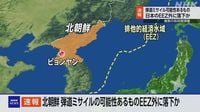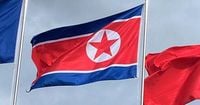On May 8, 2025, South Korea's Joint Chiefs of Staff reported that North Korea launched multiple short-range ballistic missiles towards the Sea of Japan, marking its first confirmed missile activity since March. The missiles were fired from the vicinity of Wonsan, a coastal city in eastern North Korea, at around 8:10 AM and continued until approximately 9:20 AM (Japan time).
The South Korean military stated that the missiles, of various types, reached a maximum distance of approximately 800 kilometers before landing outside Japan's Exclusive Economic Zone (EEZ). They are currently analyzing the flight distance and altitude of these missiles, which is a routine procedure following such launches.
In a statement, the South Korean Joint Chiefs of Staff emphasized their close collaboration with U.S. and Japanese forces, asserting, "We maintain full readiness and are closely sharing ballistic missile-related information with Japan and the United States." This highlights the ongoing security concerns in the region, particularly regarding North Korea's missile capabilities.
Japanese officials also reacted swiftly to the missile launches. At around 9:25 AM, Japan's Ministry of Defense confirmed the missile launches and indicated that they did not enter Japanese territory or the EEZ. Defense Minister Nakatani stated that there were no reports of damage or harm caused by the missiles. He expressed serious concern over the launches, labeling them a violation of United Nations Security Council resolutions.
Prime Minister Ishikozue, addressing the media shortly after the launches, instructed officials to prioritize information gathering and analysis. He emphasized the importance of providing timely and accurate information to the public while ensuring the safety of aircraft and ships. His statements reflect the government's commitment to maintaining public safety amid rising tensions with North Korea.
In response to the missile tests, the Japanese government convened an emergency response team to monitor the situation closely. The Coast Guard was also alerted to ensure that shipping and air traffic were not endangered by the missile activity.
This missile launch comes amid ongoing tensions in the Korean Peninsula, where North Korea has been actively testing various missile types, including hypersonic and cruise missiles, over the past year. The frequency of these tests has raised alarms in neighboring countries, prompting them to enhance their defense strategies.
North Korea's missile program has been a point of contention for years, with the international community expressing concerns over its implications for regional security. The latest launches are viewed as a demonstration of North Korea's continued advancement in missile technology and its willingness to provoke neighboring countries.
In the wake of these developments, South Korea and the United States have reiterated their commitment to responding decisively to any provocations from the North. The South Korean military has assured its citizens that it possesses the capabilities to counter any threats posed by North Korea's missile arsenal.
As the situation unfolds, analysts are closely monitoring North Korea's next moves and the potential implications for international relations in the region. The missile launches have undoubtedly intensified discussions about defense and security strategies among the U.S., South Korea, and Japan.
The broader context of these missile tests highlights the delicate balance of power in East Asia, where military posturing can lead to heightened tensions and potential conflict. Observers are urging for diplomatic solutions to address the ongoing threats posed by North Korea's military ambitions.
In summary, the missile launches on May 8, 2025, serve as a stark reminder of the persistent challenges faced by nations in the region. The international community continues to call for restraint and dialogue, hoping to avert further escalation of hostilities.







